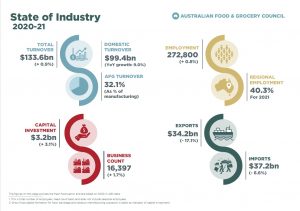New figures show Australia’s food and grocery manufacturing industry increased its value to $$133.6 billion in 2020/21. The increase came as companies weathered the disruption wrought by Covid-19, however ongoing pressures on workforces, supply chains and production costs pose a challenge to plans to secure food and grocery manufacturing’s future as a key growth industry.
The Australian Food and Grocery Council’s State of Industry (SOI) 2022 report shows the 0.9% increase in turnover for food and grocery manufacturing came despite a 17.1% decline in the value of exports as global supply chain disruptions affected sales to major export markets in Asia and the US.
AFGC CEO Tanya Barden said that during 2020/21 the food and grocery manufacturing industry stayed strong in the face of Covid-19 shutdowns and workplace disruptions. Since then, however, the pandemic, the war in Ukraine and supply chain disruptions have weighed on the growth outlook and stoked inflation.
“Food and grocery manufacturing plays a vital role keeping our supermarket shelves full and, as the nation’s largest manufacturing sector, it is central in ensuring we continue to make essential items here in Australia,” Ms Barden said.
“These figures predate the unprecedented impacts of this year’s heavy flooding in eastern and central Australia, as well as the war in Ukraine. The pressures manufacturers were facing a year ago have intensified to the point where the viability of some businesses could be at risk.”
The State of Industry 2022 report shows that for 2020/21:
- Stocking up and panic buying helped drive a spike in domestic spending – up nine per cent to $99.4 billion – that countered a 17.1% decline in exports
- Domestically, human pharmaceutical products turnover increased 50% to $2.21 billion as shoppers stocked up
- Imports declined 6.6% to $37.2 billion
- Despite the declined in exports, China remains the largest export destination for food, beverage and grocery exports (worth $7.3 billion)
- The largest increase in exports was to Vietnam, up 13.8% to $796 million
- Food and grocery manufacturing accounts for 32.1% of all Australian manufacturing activity, making it the largest manufacturing sector
- Employment in food and grocery manufacturing increased 0.8% to 272,800 people, with 40.3% of the workforce in regional areas.
The AFGC’s ‘Sustaining Australia: Food and Grocery Manufacturing 2030’ report outlines a plan to develop the industry as a major economic driver for Australia by boosting value-added production, lifting its value to $250 billion and increasing industry employment to 427,000 people by 2030.
Ms Barden said now is the time to invest in new skills, technologies and infrastructure to build industry resilience.
“The federal government has shown it understands the importance of supporting Australia’s competitive strengths, identifying food processing among the priority areas for its National Reconstruction Fund,” she said.
“Investment in Australia’s food and grocery manufacturing industry is an investment in the future and our sovereign manufacturing capacity.”





